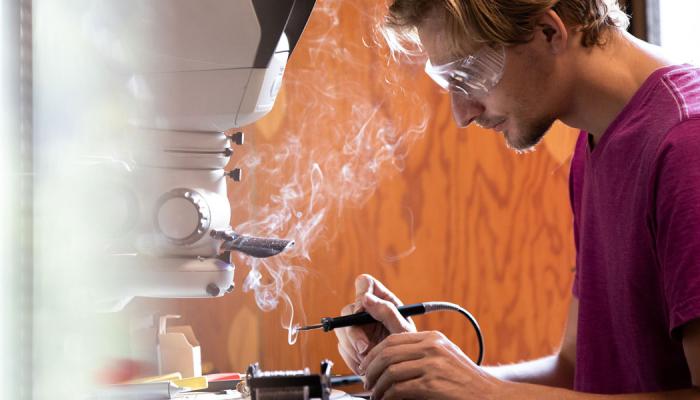Larry Sears and Sally Zlotnick Sears think[box] at the Richey Mixon Building
![Four students working with machinery at Sears think[box] at Case Western Reserve University](/president/sites/default/files/styles/hero_full_width/public/2020-05/thinkboxbuilding.jpg?h=eac637af&itok=FZhvcnYo)
A true hub of activity and innovation, the seven stories of the Larry Sears and Sally Zlotnick Sears think[box] represent a recognition of the need for students to tinker and create—and also explore ideas that could grow into commercially successful ventures with the right support.
Larry Sears, an alumnus, adjunct faculty member and university supporter, saw a need for dedicated space on campus for students to build and prototype and, with his wife, Sally Zlotnick Sears (FSM ‘72), pledged $6 million to create the Sears Undergraduate Design Lab in 2006. The space was an immediate success, prompting Sears and a small group of faculty members to approach President Snyder about a pilot program for a larger innovation center for all students. The initial think[box] space opened in the basement of an academic building in 2012.
As participation grew, President Snyder and university development professionals secured commitments to develop a bigger space; in 2016, the university began what would eventually become a full renovation of the former Lincoln Storage building into a state-of-the-art creativity and entrepreneurship hub that is free and open to the public.
Numerous supporters helped bring the project to fruition, notably:
- Larry and Sally Zlotnick Sears, whose $5 million contribution helped complete the renovation of think[box]—and led to a slight name change.
- Joseph “J.B.” Richey II and A. Malachi Mixon III, the entrepreneurs behind Invacare Corp., whose $5 million commitment is recognized with the naming of the building.
- Cloud L. Cray Jr. (CSAS ‘43) and Sally Hunter Cray, who pledged $2 million to the project and for whom the sixth-floor Center for Innovation and Entrepreneurship is named.
Far beyond a makerspace now, all seven floors have been renovated and are specifically dedicated to different stages in the process of creating and developing a product or business idea.
On any given day, students on one floor of Sears think[box] can be seen operating a 3D printer while another group on a different floor brainstorms a marketing plan for a new business, while, nearby, a student prepares a pitch deck for a start-up competition. At the same time, a venture capitalist may also be discussing a potential investment with entrepreneurs at the Veale Institute for Innovation and Entrepreneurship, which opened on the top floor in 2019.
Promoting Innovation and Entrepreneurship
President Snyder believes the spirit of entrepreneurship is strong at Case Western Reserve and is gratified by the success of Sears think[box].
“Our students have taken great advantage of this incredible resource,” President Snyder said at the dedication of the Richey Mixon building in 2015. “They have created new companies, showcased device prototypes at the Consumer Electronics Show, and participated in maker fairs and entrepreneurial events hosted by the White House.”
LaunchNet, a dedicated office to help student entrepreneurs, started in 2012 with grants from the Burton D. Morgan Foundation and the Blackstone Charitable Foundation. Staff from LaunchNet meet confidentially with students to talk through the early stages of a business idea, while also offering big-picture support, helping students learn how to pitch to investors, find national contests to enter to raise capital, and more. LaunchNet also leads the university’s presence at CES, North America’s largest innovation and technology exhibition, where CWRU students have for several years been able to present and gain international exposure for their business ideas.
Learn more about the entrepreneurial environment at Case Western Reserve University.
floors
square feet
(and growing) in sales, awards and investment dollars raised by student startups using Sears think[box] and LaunchNet since 2012

![Exterior of the Richey-Mixon Building and Sears think[box] at Case Western Reserve University](/president/sites/default/files/styles/grid_image_main/public/2020-05/thinkboxexterior.jpg?h=bde28bee&itok=0sr4Vuji)

![Interior view of the second floor of Sears think[box] at Case Western Reserve University](/president/sites/default/files/styles/grid_image_regular/public/2020-05/thinkbox3.jpg?h=bde28bee&itok=JsRE23wd)